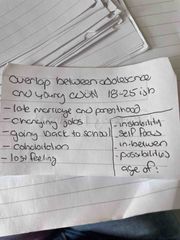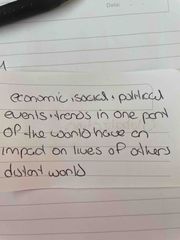![]()
![]()
![]()
Use LEFT and RIGHT arrow keys to navigate between flashcards;
Use UP and DOWN arrow keys to flip the card;
H to show hint;
A reads text to speech;
149 Cards in this Set
- Front
- Back
- 3rd side (hint)
|
Emerging Adult |

Stage |
|
|
|
Stage environment fit |

Back (Definition) |
|
|
|
Globalization |

Back (Definition) |
|
|
|
Educated consumers |
Those who understand the field of adolescence and how info is gathered allows them to judge strength and weakness of new findings |
|
|
|
How we can influence positive adolescent development |
Active learning -rephrase Deep processing -making connections |
|
|
|
Transitions into adolescence |
Normative -changes that happen roughly same time -school and puberty Idiosyncratic- unpredictable like illness or divorce |
|
|
|
Early adolescence |
11-14 |
|
|
|
Middle adolescence |
15-18 |
|
|
|
Late adolescence |
19-22 |
|
|
|
Life-cycle service |
Leave families at early age to spend adolescents in a different household To strengthen personal and political ties |
|
|
|
Storm and stress |
Belief that adolescence is very tumultuous period |
|
|
|
Age stratification |
Defining groups based on age and treated differently |
|
|
|
Consumerism |
Wanting all the current popular things |
|
|
|
Youth culture |
Grouped with ages in schools Began being seen a separate encouraged youth culture |
|
|
|
Reproductive fitness |
Darwin Genetic characteristics make survival offspring more likely |
|
|
|
Ecological systems |
Brofenbrenner- Interacting between adolescent and his surroundings like family and peers and community |
|
|
|
Applications |
Taking knowledge from research and applying |
|
|
|
Developmental tasks |
Skills that society expects people to squire at a particular point in life |
|
|
|
Inventionism |
Adolescence promoted in early 20th century |
|
|
|
Peers |
Same age or development level |
|
|
|
Urbanization |
Trend for young people to to leave country for the city |
|
|
|
Psychosexual stages |
Freud |
|
|
|
Psychosocial stages |
Erickson - development and interaction with environment |
|
|
|
Cognitive stages |
Piaget different ways of building an understanding of the world Formal operations -logic and abstract thought |
|
|
|
Metacognition |
Ability to be aware of one’s own thinking processes and develop more effective ways of using them |
|
|
|
Metacognition |
Ability to be aware of one’s own thinking processes and develop more effective ways of using them |
|
|
|
Operant conditioning |
Skinner Learning behaviour by consequences |
|
|
|
Social cognitive theory |
Bandura Seeing what others do and what happens to them |
|
|
|
Ecological theory |
Bronfenbrenner Social setting influence development. |
|
|
|
Brain growth in first year |
100% By age 10 it is 95% |
|
|
|
Synaptic pruning |
Neurons lose half their synapses during adolescence |
|
|
|
Endocrine system |
Glands that produce hormones and parts of the Brian and nervous system that regulates hormone production. |
|
|
|
Hormones |
Chemical substances that circulate through the bloodstream and regulate functions |
|
|
|
Hormones |
Chemical substances that circulate through the bloodstream and regulate functions |
|
|
|
Hypothalamus |
Part of the Brian that monitors and regulates body functions like hormones for growth and puberty |
|
|
|
Pituitary |
A endocrine glad that is considered the master gland as it controls the functions of other glands |
|
|
|
Pituitary |
A endocrine glad that is considered the master gland as it controls the functions of other glands |
|
|
|
Estrogen |
Female sex hormone secreted by ovaries |
|
|
|
Androgens |
Male sex hormones |
Testosterone secreted by testes |
|
|
HPG axis |
Feedback loop that regulates the hormones involved in puberty and growth |
|
|
|
Adrenarche |
Early puberty when adrenal glands begin to produce a hormone called DHEA |
|
|
|
Insulin like growth factor -I |
A substance produced in the liver that maybe linked to onset of puberty |
|
|
|
Insulin like growth factor -I |
A substance produced in the liver that maybe linked to onset of puberty |
|
|
|
Adolescent growth spurt |
10-16 for girls 12-18 for boys |
|
|
|
Insulin like growth factor -I |
A substance produced in the liver that maybe linked to onset of puberty |
|
|
|
Adolescent growth spurt |
10-16 for girls 12-18 for boys |
|
|
|
Peak height |
Fastest change in height 12 girls 14 boys |
|
|
|
Insulin like growth factor -I |
A substance produced in the liver that maybe linked to onset of puberty |
|
|
|
Adolescent growth spurt |
10-16 for girls 12-18 for boys |
|
|
|
Peak height |
Fastest change in height 12 girls 14 boys |
|
|
|
Pheromones |
Airborne chemicals thought to signal emotional states to others |
|
|
|
Insulin like growth factor -I |
A substance produced in the liver that maybe linked to onset of puberty |
|
|
|
Adolescent growth spurt |
10-16 for girls 12-18 for boys |
|
|
|
Peak height |
Fastest change in height 12 girls 14 boys |
|
|
|
Pheromones |
Airborne chemicals thought to signal emotional states to others |
|
|
|
Secular trend |
Change over a long period. Kids are hitting puberty earlier now. Environmental factors can have factor in that |
|
|
|
Semenarche |
Boys first ejaculation |
|
|
|
Semenarche |
Boys first ejaculation |
|
|
|
Deviance hypothesis |
Those who enter puberty at a noticeably different time from peers will be neg influenced |
|
|
|
Stage termination hypothesis |
Idea that girls who enter puberty early suffer because they did not have time to accomplish normal childhood tasks |
|
|
|
Adult resemblance hypothesis |
Young adolescence who look older will be treated more like an amulet for better or worse |
|
|
|
Distancing hypothesis |
As children become more sexually mature they have less contact with parents |
|
|
|
Piaget and cognitive development |
Everyone goes through the same stages and in the same order. Children’s thinking is not just how much they know but how they think about what they know. |
|
|
|
Assimilation |
The way someone tries to understand a new experience by making it fit with existing knowledge or understanding |
|
|
|
Accommodation |
Changing your cognitive structures in response to new information or experiences |
|
|
|
Accommodation |
Changing your cognitive structures in response to new information or experiences |
|
|
|
Paiget’s stages |
Sensorimotor 0-2 experience based on perception Preoperational 2-7 ability to represent objects and events symbolically Concrete 7-11 able to think about more than one aspect of a problem Formal 11+ abstract system of logic to understand the world |
|
|
|
Competence performance gap |
How people don’t constantly do as well at some tasks that they are capable of doing |
|
|
|
Competence performance gap |
How people don’t constantly do as well at some tasks that they are capable of doing |
|
|
|
Hypothetico-deductive reasoning |
When a person makes a logical prediction based on suspicion |
|
|
|
Inductive reasoning |
The process of drawing a general conclusion from particular facts |
|
|
|
Divided attention |
The ability to do more than one thing at once. Improves with age |
|
|
|
Fuzzy trace theory |
We store info in memory in bits and pieces relevant. Starts in adolescence |
|
|
|
Fluid intelligence |
Ability to reason quickly and effectively about problems |
|
|
|
Crystallized intelligence |
The ability to draw on accumulated knowledge and judgement |
|
|
|
Triarchic theory of intelligence |
Sternberg- different intelligences represent different independent abilities Practical creative and analytical |
|
|
|
Multiple intelligences |
Gardner - intelligence is separate by particular domain |
|
|
|
Flynn effect |
Averaging IQ scores |
|
|
|
Self regulated learning |
Control over steps that lead to developing skills and improve learning |
|
|
|
Personal epistemology |
The different ways adolescence think about what knowledge is and what it’s based on |
|
|
|
Critical thinking |
Connecting new info with existing understanding, analyzing, making decision |
|
|
|
Inductive reasoning |
The process of drawing a general conclusion from particular facts |
|
|
|
Egocentrism |
For Piaget- Assuming that others views are the same as your own |
|
|
|
Imaginary audience |
Aspect of egocentrism that involves believing that you are the focus of others attention |
|
|
|
Personal fable |
Elkind- Believing that one’s experiences are unique and that you are exempt from the usual consequences of your actions |
|
|
|
Vygotsky |
The role of others such as older peers and adults important in promoting cognitive development |
|
|
|
Zone of proximal development |
Vig- tasks that kids can’t do on their own can be accomplished with the help from someone skilled |
|
|
|
Scaffolding |
Adapting one’s guidance and support to the current level of knowledge and understanding of the learner |
|
|
|
Executive control structures |
Mental representation of goals and strategies that make it possible to approach problems more effectively |
|
|
|
Selective attention |
Concentrating on one task while blocking out others |
|
|
|
Intersex |
Male and female characteristics |
|
|
|
Sex difference |
Difference based on chromosomes |
|
|
|
Gender difference |
Based on cultural or social factors |
|
|
|
Gender role |
The way someone should act cultural expectations |
|
|
|
Gender typing |
Children take on gender roles expected in society |
|
|
|
Socialization |
Process which children squire beliefs and skills thats considered appropriate |
|
|
|
Gender consistency |
That a boy who dresses up like a girl still grows up to be a boy |
|
|
|
Gender identity |
How a person relates to masculinity or femininity |
|
|
|
Gender schema theory |
How we organize information about gender and use it to guide attitudes and actions |
|
|
|
Gender intensification hypothesis |
Adolescence pressured to confirm more closely to expected gender role |
|
|
|
Transgendered |
Anatomy of one sex but identifies as the other |
|
|
|
Learned helplessness |
When someone thinks failure was uncontrolled so why bother trying |
|
|
|
Stereotype threat |
Girls bad a math, creates anxiety that they will actually do bad and prove the stereotype |
|
|
|
Co-rumination |
Girls more often rehash problems, over talk it out |
|
|
|
Homophobia |
Negative feelings against same sex attraction |
|
|
|
Androgyny |
Having both typical male and female psychological (emotional) characteristics |
|
|
|
Socialization approaches |
What society does to shape us |
|
|
|
Social cognition theory |
Bandura monkey see monkey do. Social influences on how we act |
|
|
|
Self efficacy |
Our own belief in what we are capable of achieving |
|
|
|
Acculturation |
Assimilation to a different culture, typically a dominate one |
|
|
|
Acculturation |
Assimilation to a different culture, typically a dominate one |
|
|
|
Self concept |
How you think about yourself |
|
|
|
Possible selves |
How you could be with different circumstance |
|
|
|
Looking glass self |
Cooley We find out about ourselves from watching the way other respond to us |
|
|
|
Generalized other |
Meads Internal summary of how others have responded to them |
|
|
|
Self esteem |
Positive or negative feelings about oneself |
|
|
|
Baseline self esteem |
Your constant/stable self esteem |
|
|
|
Barometric self esteem |
Changes in self esteem due to incidents |
|
|
|
Identity |
The psychological structure that gives people a sense of personal community across situations |
|
|
|
Identity crisis |
Erickson Response to tensions between the need to find oneself and validation From others |
|
|
|
Psychosocial moratorium |
Freedom to explore without fear of consequences Ekrison |
|
|
|
Identity foreclosure |
Commit to assigned identities by parents |
|
|
|
Identity diffusion |
Reluctance to consider identity issues. Failure to construct any identity of self F |
|
|
|
Negative identity |
Acting out to guarantee disapproval and attention |
|
|
|
Identity exploration |
Marcia Examining alternatives |
|
|
|
Identity exploration |
Marcia Examining alternatives |
|
|
|
Identity status |
Marcia The presence or absence of efforts and commitment |
|
|
|
Identity exploration |
Marcia Examining alternatives |
|
|
|
Identity status |
Marcia The presence or absence of efforts and commitment |
|
|
|
Identity style |
Way people deal with info that relates to questions of identity |
|
|
|
Ethnicity |
Cultural background and customs |
|
|
|
Ethno-cultural identity |
Understanding one self in terms of one’s culture |
|
|
|
Ethno-cultural identity |
Understanding one self in terms of one’s culture |
|
|
|
Code switching |
Cognitive and linguistic changes that take place when someone who is bilingual switches language |
|
|
|
Cultural frame |
Attitude and ways of thinking when you speak a different language |
|
|
|
Hetronomous mortality |
Piaget Early Moral development. Kids learn adults can change rules |
|
|
|
Immanent justice |
Belief that wrongdoing is always punished. Kids |
|
|
|
Autonomous mortality |
Piaget Later phase moral development rules are changeable actions more weight than outcome |
|
|
|
Pre-conventional mortality |
Kolberg Level of judgement which right and wrong defined in terms of external punishment and rewards - right reward, wrong punish. One point of view |
|
|
|
Conventional morality |
Level of judgement of right and wrong equal to society |
|
|
|
Post conventional morality |
Write or wrong based on own morals |
|
|
|
Justice orientation |
Approaching moral questions with goal of finding fair resolution Gillian |
|
|
|
Care orientation |
Gilligan Approaching moral questions with the goal of maintaining positive relationship |
|
|
|
Super ego |
Freud Guilt drives structure of personality and morals |
|
|
|
Empathy |
The capacity to feel what others are feeling |
|
|
|
Induction |
Disciplinary approach where parents explain effects of an action on others |
|
|
|
Power assertion |
Disciplinary approach parents threaten with loss of affection |
|
|
|
Moral identity |
Acting moral is essential to sense of self |
|
|
|
Moral examplar |
A person who others regard as outstanding morals |
|

